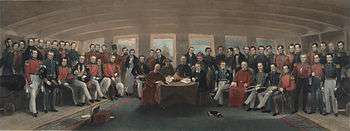Peter Richards (Royal Navy officer)
| Sir Peter Richards | |
|---|---|
|
Signing of the Treaty of Nanking (1842). Richards is seated in the front row (second from right) between Maj. George Malcolm and Lt. Col. Francis Spencer Hawkins. | |
| Born | 1787 |
| Died | March 1869 |
| Allegiance |
|
| Service/branch |
|
| Years of service | 1798–1865 |
| Rank | Admiral |
| Commands held |
HMS Asia HMS Volage HMS Cornwallis HMS Hibernia HMS Royal Sovereign HMS Cumberland HMS Boscawen |
| Battles/wars |
First Opium War Crimean War |
| Awards | Knight Commander of the Order of the Bath |
Admiral Sir Peter Richards KCB (1787 – March 1869) was a Royal Navy officer who went on to be Third Naval Lord.
Naval career
Richards joined the Royal Navy in 1798.[1] Promoted to Captain in 1828, Richards was given command of HMS Asia and HMS Volage before commanding HMS Cornwallis in the First Opium War.[1] He later commanded HMS Hibernia, HMS Royal Sovereign, HMS Cumberland and HMS Boscawen.[1] He was appointed Third Naval Lord in 1854 and served in that role during the Crimean War.[1]
St. Peter's Memorial Mission Chapel at Saltash Passage near St Budeaux in Cornwall was built in his memory but damaged in World War II and then demolished in 1956.[2][3]
See also
- O'Byrne, William Richard (1849). "
 Richards, Peter".
Richards, Peter".  A Naval Biographical Dictionary. John Murray. Wikisource.
A Naval Biographical Dictionary. John Murray. Wikisource.
References
- 1 2 3 4 William Loney RN
- ↑ The Phillimore Papers National Archives
- ↑ Moseley, Brian (June 2011). "Mission Chapel of Saint Peter". The Encyclopaedia of Plymouth History. Plymouth Data. Archived from the original on 4 March 2012. Retrieved 15 February 2015.
| Military offices | ||
|---|---|---|
| Preceded by Sir Richard Dundas |
Third Naval Lord 1854–1857 |
Succeeded by Henry Eden |
This article is issued from Wikipedia - version of the 9/5/2016. The text is available under the Creative Commons Attribution/Share Alike but additional terms may apply for the media files.
